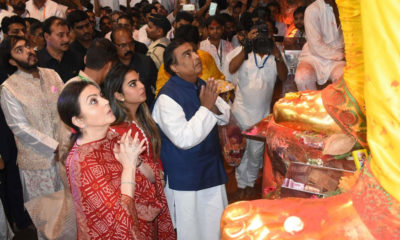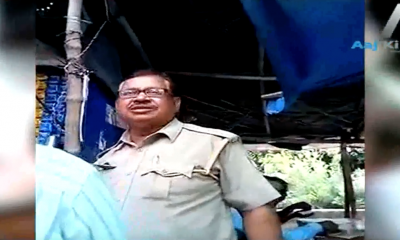Feature
Sheena probe team not removed: New police chief

Mumbai: Mumbai Police’s new chief Javed Ahmed on Tuesday denied that the team investigating the Sheena Bora murder case has been shunted out.
“The joint police commissioner has categorically said that the team (probing the Sheena Bora killing) has not been removed. All aspects of the case, financial or otherwise shall be thoroughly investigated,” Ahmed said, responding to a volley of questions on the issue.
However, he added that which branch or team (of the police department) would investigate any case is an internal matter of the police department.
“The issue before us is that the case should be handled properly and evidences collected must be such that it becomes a complete case when it goes for trial,” Ahmed said.
Ahmed took over from Maria – who has been promoted as DGP-Home Guard, in a surprise move barely 22 days before the scheduled expiry of the latter’s term as city police chief on September 30.
The new police commissioner’s reaction came shortly after taking over the post to a barrage of media questions whether the investigating team – handpicked for the Sheena Bora murder case – has been removed along with the former police chief Rakesh Maria.
He pointed out that probe into any case is “a collective team work”, and the accused in the case – Indrani Mukherjea and her former driver Shyamvar Rai – are now in judicial custody.
“As for the ongoing investigations, we shall monitor it in the right and professional way. We shall also inform the media the factual and correct developments in the case,” Ahmed said.
On his immediate agenda as the new police chief, he said priority would be for security and ensuring law and order, safety of women and children, service delivery both inside and outside the police stations to common citizens, and easy and open access to the men and officers of the police force to address peoples’ grievances.
He also assured that the police would aim to ensure safe and peaceful celebrations of the 10-day long Ganeshotsav starting on September 17 and the Bakri Eid festival.
Entertainment
Meghalaya Reserves Legalized Gambling and Sports Betting for Tourists

The State Scores Extra High on Gaming-Friendly Industry Index
Meghalaya scored 92.85 out of 100 possible points in a Gaming Industry Index and proved to be India’s most gaming-friendly state following its recent profound legislation changes over the field allowing land-based and online gaming, including games of chance, under a licensing regime.
The index by the UK India Business Council (UKIBC) uses a scale of 0 to 100 to measure the level of legalisation on gambling and betting achieved by a state based on the scores over a set of seven different games – lottery, horse racing, betting on sports, poker, rummy, casino and fantasy sports
Starting from February last year, Meghalaya became the third state in India’s northeast to legalise gambling and betting after Sikkim and Nagaland. After consultations with the UKIBC, the state proceeded with the adoption of the Meghalaya Regulation of Gaming Act, 2021 and the nullification of the Meghalaya Prevention of Gambling Act, 1970. Subsequently in December, the Meghalaya Regulation of Gaming Rules, 2021 were notified and came into force.
All for the Tourists
The move to legalise and license various forms of offline and online betting and gambling in Meghalaya is aimed at boosting tourism and creating jobs, and altogether raising taxation revenues for the northeastern state. At the same time, the opportunities to bet and gamble legally will be reserved only for tourists and visitors.
“We came out with a Gaming Act and subsequently framed the Regulation of Gaming Rules, 2021. The government will accordingly issue licenses to operate games of skill and chance, both online and offline,” said James P. K. Sangma, Meghalaya State Law and Taxation Minister speaking in the capital city of Shillong. “But the legalized gambling and gaming will only be for tourists and not residents of Meghalaya,” he continued.
To be allowed to play, tourists and people visiting the state for work or business purposes will have to prove their non-resident status by presenting appropriate documents, in a process similar to a bank KYC (Know Your Customer) procedure.
Meghalaya Reaches Out to a Vast Market
With 140 millions of people in India estimated to bet regularly on sports, and a total of 370 million desi bettors around prominent sporting events, as per data from one of the latest reports by Esse N Videri, Meghalaya is set to reach out and take a piece of a vast market.
Estimates on the financial value of India’s sports betting market, combined across all types of offline channels and online sports and cricket predictions and betting platforms, speak about amounts between $130 and $150 billion (roughly between ₹9.7 and ₹11.5 lakh crore).
Andhra Pradesh, Telangana and Delhi are shown to deliver the highest number of bettors and Meghalaya can count on substantial tourists flow from their betting circles. The sports betting communities of Karnataka, Maharashtra, Uttar Pradesh and Haryana are also not to be underestimated.
Among the sports, cricket is most popular, registering 68 percent of the total bet count analyzed by Esse N Videri. Football takes second position with 11 percent of the bets, followed by betting on FIFA at 7 percent and on eCricket at 5 percent. The last position in the Top 5 of popular sports for betting in India is taken by tennis with 3 percent of the bet count.
Local Citizens will Still have Their Teer Betting
Meghalaya residents will still be permitted to participate in teer betting over arrow-shooting results. Teer is a traditional method of gambling, somewhat similar to a lottery draw, and held under the rules of the Meghalaya Regulation of the Game of Arrow Shooting and the Sale of Teer Tickets Act, 2018.
Teer includes bettors wagering on the number of arrows that reach the target which is placed about 50 meters away from a team of 20 archers positioned in a semicircle.
The archers shoot volleys of arrows at the target for ten minutes, and players place their bets choosing a number between 0 and 99 trying to guess the last two digits of the number of arrows that successfully pierce the target.
If, for example, the number of hits is 256, anyone who has bet on 56 wins an amount eight times bigger than their wager.

















